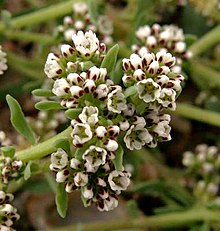Deer jump (plant)
| Deer jump | ||||||||||||
|---|---|---|---|---|---|---|---|---|---|---|---|---|

Deer jump ( Corrigiola litoralis ) |
||||||||||||
| Systematics | ||||||||||||
|
||||||||||||
| Scientific name | ||||||||||||
| Corrigiola litoralis | ||||||||||||
| L. |
The Common Hirschsprung ( Corrigiola litoralis ), also Common Hirschsprung or Shore Hirschsprung called, is a plant of the genus Corrigiola within the family of the Pink family (Caryophyllaceae).
description
Vegetative characteristics
The common deer jump grows as a bare, annual herbaceous plant that is richly branched at the bottom. The prostrate stems usually reach lengths of 7 to 25, rarely up to 50 centimeters. The growth form often resembles flat cushions lying on the ground. The plant appears overall blue to gray-green, the alternate leaves have a linear to narrow-lanceolate, spatulate outline. There are very small stipules at their base .
Generative characteristics
The flowering period in Central Europe extends from July to September or October. The flowers are in dense, axillary or terminal clusters together. The hermaphroditic flowers are radial symmetry and five-fold with a double flower envelope. The skin-margined sepals are egg-shaped with a length of 1 to 1.5 millimeters. The whitish petals are shorter than the sepals. Each flower contains five stamens and three styles . The fruit is 1 to 1.5 millimeters long.
Chromosome number
The number of chromosomes is 2n = 16, 18 (32) or 54.
ecology
The common deer jump is a therophyte . Usually the flowers are found to be spherical closed; the common deer jump is self-pollinating .
Occurrence and endangerment
The common deer jump is a subatlantic to sub-Mediterranean floral element , which has its area focus in Western Europe and in western to central Central Europe. In the north it occurs as far as central Sweden and south-west Finland, in the Mediterranean it can be found in coastal areas. In America and South Africa the common deer jump is a neophyte . The common deer jump is the only one that occurs in Central Europe.
The common deer jump occurs from the lowlands to the middle of the mountains, in the Black Forest up to about 820 meters; it is absent in the Alps.
The common deer jump inhabits moist sandy locations on river banks and in other open, alternately wet pioneer corridors. The common deer jump is a river valley plant in large river valleys, for example on the middle Elbe , which occurs on the banks along the changing water zone, as well as in some reservoirs and dams. In addition, it can be found as a sand plant ( psammophyte ) on crooked fields, unpaved roads and similar open raw soil locations (also: military training areas, railway systems, industrial sites). It needs low-vegetation, dry to alternately wet (sometimes occasionally flooded), moderately nutrient-rich and sandy, gravel or gravel soils that are rather low in base and lime. According to the ecological pointer values of Ellenberg, Hirschsprung is a light plant, moderately heat-loving, oceanic widespread and a moisture and moderately acid pointer.
Phytosociological is the commons Hirschsprung to the eponymous character species of rare Hirschsprung society Chenopodio polyspermi-Corrigioletum littoralis (Malcuit 1929) Hülbusch & R. Tx. in R. Tx. 1979, which is transferred to the dwarf rush companies. Furthermore, the common deer jump occurs in other societies of the river reporting corridors (Association Chenopodion rubri).
The common deer jump is a weak competitive plant with specific ecological demands. Declines in the species are observed in various countries and regions; therefore it is, for example, on Germany's red list as "endangered".
Taxonomy
Corrigiola litoralis was first published in 1753 by Carl von Linné in Species Plantarum , 1, p. 271.
Common names
The other German-language trivial names Lingenkraut, Brown Knot Grass, Strändling and Uferlingenkraut also existed or existed for the Hirschsprung .
swell
- Hirschsprung (plant). In: FloraWeb.de.
literature
- Heinz Ellenberg : Pointer values of the vascular plants of Central Europe. Scripta Geobotanica IX, 2nd edition, Erich Goltze KG, Göttingen 1979.
- Eckhard Garve: Atlas of the endangered fern and flowering plants in Lower Saxony and Bremen. Nature conservation landscape conservation Lower Saxony 30, Hanover 1994, ISBN 3-922321-68-2
- Henning Haeupler, Thomas Muer: picture atlas of the fern and flowering plants of Germany . Ed .: Federal Agency for Nature Conservation (= The fern and flowering plants of Germany . Volume 2 ). Eugen Ulmer, Stuttgart (Hohenheim) 2000, ISBN 3-8001-3364-4 .
- Erich Oberdorfer : Plant-sociological excursion flora . With the collaboration of Theo Müller. 6th, revised and expanded edition. Eugen Ulmer, Stuttgart (Hohenheim) 1990, ISBN 3-8001-3454-3 .
- Richard Pott: The plant communities in Germany. UTB, Ulmer, Stuttgart 1992, ISBN 3-8252-8067-5
Web links
- Data sheet for profiles on vascular plants in Bavaria from the Bavarian Botanical Information Node .
- Data sheet at InfoFlora, the internet portal of the national data and information center on Swiss flora .
- Distribution map for Germany. In: Floraweb .
- Map for worldwide distribution at linnaeus.nrm.se
- Thomas Meyer: Data sheet with identification key and photos at Flora-de: Flora von Deutschland (old name of the website: Flowers in Swabia )
Individual evidence
- ^ Erich Oberdorfer : Plant-sociological excursion flora for Germany and neighboring areas . With the collaboration of Angelika Schwabe and Theo Müller. 8th, heavily revised and expanded edition. Eugen Ulmer, Stuttgart (Hohenheim) 2001, ISBN 3-8001-3131-5 , pp. 389 .
- ^ Corrigiola litoralis at Tropicos.org. In: IPCN Chromosome Reports . Missouri Botanical Garden, St. Louis
- ^ Georg August Pritzel , Carl Jessen : The German folk names of plants. New contribution to the German linguistic treasure. Philipp Cohen, Hannover 1882, p. 114. ( online ).


